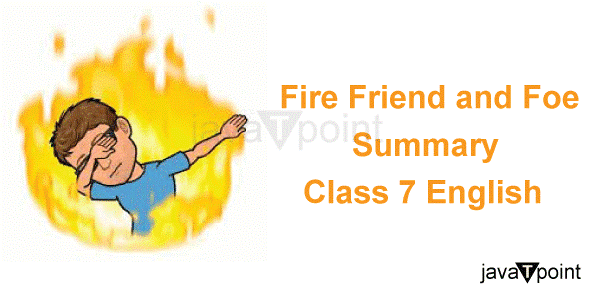Fire Friend and Foe Summary Class 7 EnglishThe summary for Class 7 English Fire Friends and Foe is provided below. The lesson on Fire Friend and Foe will be simple for Class 7 students to comprehend after reading the in-depth summary. After reading the summary, students can quickly respond to any questions about the chapter. Students can use the Class 7 English summary as they study for the test. 
It's a good lesson to learn. It is challenging to envision our life without fire. One of the most significant finds in human history is fire. However, it must be checked because if it grows out of hand, it might wreak disaster. Water, sand, and other materials can be used to put it out if a fire does start, and numerous other firefighting tools can also be used. If the fire spreads out of control, hectares of wood, people, and buildings are destroyed. Summary
The ability to create fire was unknown to early man. However, he undoubtedly witnessed fire's terrible force. He must have observed volcanoes and lightning. He was terrified by it. Explain fire. In actuality, fire is the outcome of a chemical interaction. Fuels include carbon and hydrogen, whereas the air contains oxygen. Heat and light are produced due to the interaction between the two. We refer to this as fire. Fuel, oxygen, and heat are required to create a fire. Wood, coal, gas, and petrol are the most prevalent fuels. Air is where oxygen originates from. That explains why burning paper catches on fire when we blow on it. Fire is not created by fuel and oxygen by itself. They want warmth. A lighted match provides that heat. Every fuel has a specified start temperature at which it begins to burn. Despite being a great servant, fire makes a horrible master. It is helpful when it is under control. As soon as it grows out of control, chaos results. Each year, fires cause hundreds of homes and trees to suffer damage. Forest fires harm people and ruin trees. Three methods exist for putting out a fire. We can remove the fuel or prevent oxygen from getting to the burning material. Reduce the temperature below the flash point as a third option. The candle will go out if the heated air surrounding it is removed. Additionally, water decreases the temperature and eliminates fire. Water alone won't extinguish some flames. One such instance is an oil fire. The oil spreads and burns while floating to the surface of the water. Water cannot put out an electrical fire either. Carbon dioxide is used in its defense. Overall, we have developed solid fire management and practical application skills. There were no firefighters long ago. Buckets of water would be brought and thrown on the flames by the crowds. There are now rules requiring fire extinguishers in every large structure. Every town has a fire department. Trained firefighters employ techniques such as turning off power supplies, ripping down weak walls, and spraying water to put out fires. They have received first aid instruction as well. Many sections of the world still practice fire worship. Keeping away from animals and settling in secure areas aided early man. Conclusion Fire is, therefore, both an excellent servant and a dreadful master. When used correctly, it may be a blessing; it might, however, become a curse if it spirals out of hand. As a result, we must practice fire safety and take protective precautions. We should respect firefighters who risk their lives to safeguard us and our property.
Next TopicFra Lippo Lippi Summary
|
 For Videos Join Our Youtube Channel: Join Now
For Videos Join Our Youtube Channel: Join Now
Feedback
- Send your Feedback to [email protected]
Help Others, Please Share









